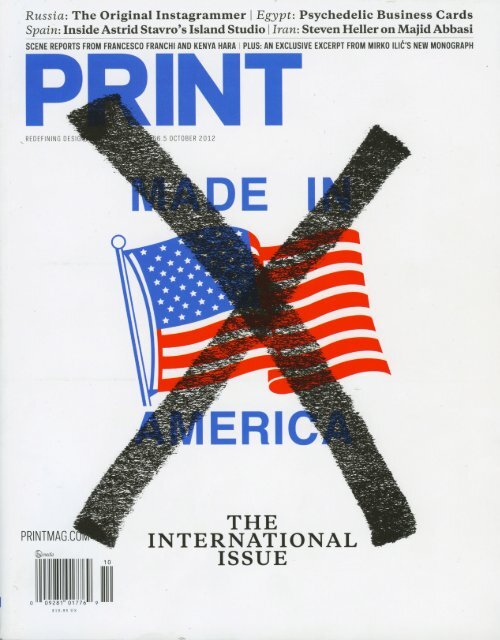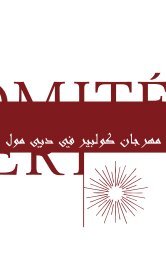On pur pose, we turn words into puz zles, to in ... - Les Graphiquants
On pur pose, we turn words into puz zles, to in ... - Les Graphiquants
On pur pose, we turn words into puz zles, to in ... - Les Graphiquants
Create successful ePaper yourself
Turn your PDF publications into a flip-book with our unique Google optimized e-Paper software.
l<strong>in</strong>es<br />
of<br />
com<br />
muni<br />
cat<br />
ion<br />
by vÉronique vienne<br />
<strong>to</strong> get its message across,<br />
wants <strong>to</strong> change<br />
a Parisian design studio<br />
the way <strong>we</strong> read.<br />
béjean<br />
This unsigned poster—by pascaL<br />
<strong>Les</strong> <strong>Graphiquants</strong> and<br />
by<br />
FranÇois Kenesi—has<br />
appeared at 900 publictransit<br />
stations <strong>in</strong> France. porTraiTs<br />
42 pr<strong>in</strong>t 66.5 oc<strong>to</strong>ber 2012 pr<strong>in</strong>tmag.com 43
<strong>Les</strong> <strong>Graphiquants</strong>’ posters<br />
for recent dance and<br />
music biennials <strong>in</strong> Lyon<br />
I<br />
n 2009, after just a year <strong>in</strong><br />
bus<strong>in</strong>ess, the pr<strong>in</strong>cipals of a small<br />
design studio <strong>in</strong> Paris called <strong>Les</strong><br />
<strong>Graphiquants</strong> decided <strong>to</strong> pr<strong>in</strong>t a<br />
brochure of their work. They created<br />
a handsome 42-page, four-color<br />
presentation show<strong>in</strong>g examples of their<br />
best posters and brochures as <strong>we</strong>ll as some<br />
of their personal projects. It was all very<br />
impressive and beautifully laid out, save<br />
for the fact that the writ<strong>in</strong>g—all of it, <strong>in</strong>clud<strong>in</strong>g<br />
the captions—was <strong>in</strong> Lorem ipsum<br />
dummy text.<br />
It was surreal: every head<strong>in</strong>g, subhead<strong>in</strong>g,<br />
blurb, footnote, and pho<strong>to</strong> credit was<br />
carefully and elegantly handled <strong>in</strong> Lat<strong>in</strong>.<br />
(Take that, David Carson!) I called <strong>Les</strong> <strong>Graphiquants</strong>’ office and<br />
asked Cyril Taieb, one of its four pr<strong>in</strong>cipals, what sort of feedback<br />
they got on the brochure. “Friends loved it!” he said, add<strong>in</strong>g<br />
that the work should speak for itself—and that, anyway, nobody<br />
ever reads what’s written <strong>in</strong> these th<strong>in</strong>gs.<br />
“You don’t th<strong>in</strong>k that readers want <strong>to</strong> know the name of the<br />
project or the client?” I asked. “It’s irrelevant <strong>in</strong>formation,” he<br />
said. “So quickly forgotten.” We <strong>we</strong>re on the phone, but I could<br />
tell that he was shrugg<strong>in</strong>g his shoulders.<br />
That was three years ago. Today, <strong>Les</strong> <strong>Graphiquants</strong> (<strong>in</strong> French,<br />
the name suggests that they are graphic “traffickers”) are one of<br />
the largest <strong>in</strong>dependent graphic design studios <strong>in</strong> Paris, with<br />
enough work <strong>to</strong> keep close <strong>to</strong> a dozen people on the payroll. The<br />
list of their clients <strong>in</strong>cludes the Centre Pompidou, the French<br />
cultural m<strong>in</strong>istry, Canal+, and a handful of prestigious music<br />
and dance festivals. In fact, their work seems <strong>to</strong> pop up everywhere<br />
these days, which has led some of the city’s more established<br />
designers <strong>to</strong> dismiss it as “stylistic” or lack<strong>in</strong>g substance.<br />
The graphic designer Pascal Béjean shares some of these reservations<br />
but has nonetheless found himself won over by the<br />
studio’s output. (He <strong>to</strong>ok the portraits seen on these pages.) “Even<br />
though I somehow feel that these guys’ work can be a bit <strong>to</strong>o slick<br />
or <strong>to</strong>o trendy,” he says, “there is always someth<strong>in</strong>g that draws me<br />
<strong>to</strong> it—whether it’s the composition, the typography, the <strong>in</strong>tricacies<br />
of the layout, or their pho<strong>to</strong>graphs. They started so strong,<br />
so now I am expect<strong>in</strong>g greater th<strong>in</strong>gs from them <strong>in</strong> the future.”<br />
<strong>Les</strong> <strong>Graphiquants</strong>’ pr<strong>in</strong>cipals are not fully comfortable with<br />
the attention that their work has received. “We have trouble def<strong>in</strong><strong>in</strong>g<br />
what <strong>we</strong> do,” Taieb says. “Giv<strong>in</strong>g <strong>in</strong>terviews is <strong>to</strong>rture. We<br />
are deadly afraid of sound<strong>in</strong>g pretentious.” This is practically<br />
unheard of <strong>in</strong> France, where fail<strong>in</strong>g <strong>to</strong> develop a complex discourse<br />
<strong>to</strong> expla<strong>in</strong> your work is frowned upon—particularly among<br />
Parisian designers, who sometimes seem <strong>to</strong> spend as much time<br />
justify<strong>in</strong>g their approach as they do deliver<strong>in</strong>g the goods.<br />
But be<strong>in</strong>g tight lipped about explanations does not preclude<br />
hav<strong>in</strong>g a <strong>we</strong>ll-def<strong>in</strong>ed po<strong>in</strong>t of view, and <strong>Les</strong> <strong>Graphiquants</strong> certa<strong>in</strong>ly<br />
have a dist<strong>in</strong>ctive signature. Their work is steeped <strong>in</strong> levity.<br />
Over and over aga<strong>in</strong>, their designs seems <strong>to</strong> defy gravity and float<br />
on the page <strong>in</strong> breathless suspension. As the design critic Van<strong>in</strong>a<br />
P<strong>in</strong>ter <strong>to</strong>ld me, “they always manage <strong>to</strong> evoke buoyancy,” an effect<br />
that she ascribes <strong>to</strong> “a deceptively simple <strong>in</strong>teraction bet<strong>we</strong>en<br />
flat surfaces and playful letterforms.”<br />
Recent posters for the Lyon Dance Biennale are a perfect example.<br />
In them, leap<strong>in</strong>g dancers are frozen midair among swarms<br />
of what look like golf balls. “We love <strong>to</strong> create ‘clouds’ of objects<br />
whose <strong>we</strong>ight becomes <strong>in</strong>substantial,” says Maxime Tétard, another<br />
of <strong>Les</strong> <strong>Graphiquants</strong>’ pr<strong>in</strong>cipals. “We play with<br />
counter<strong>in</strong>tuitive perceptions. We encourage vie<strong>we</strong>rs <strong>to</strong> question<br />
their expectations.”<br />
The golf-balls theme, which they call “molecules,” is part of a<br />
larger field of research: the study of self-generat<strong>in</strong>g figures. Tétard<br />
and Roma<strong>in</strong> Rachl<strong>in</strong>, who act as <strong>Les</strong> <strong>Graphiquants</strong>’ art direc<strong>to</strong>rs<br />
(Taieb handles communications and production, and the fourth<br />
pr<strong>in</strong>cipal, François Dubois, is <strong>in</strong> charge of multimedia work),<br />
share a passion for experimental geometry. They are obsessed<br />
with folded-paper shapes, patterns made of randomly assembled<br />
solids, and handsome letterforms that look like they have been<br />
punched out by a cookie cutter or popped out of a cake mold.<br />
Tétard and Rachl<strong>in</strong> like <strong>to</strong> say that they are herd<strong>in</strong>g forms,<br />
much as a shepherd does his flock. They collaborate with the<br />
material world, coax and cajole it, rather than try <strong>to</strong> bridle it.<br />
They hate <strong>to</strong> force th<strong>in</strong>gs <strong><strong>in</strong><strong>to</strong></strong> existence. Indeed, the studio's most<br />
memorable work <strong>to</strong> date, a series of viral posters that have now<br />
made their way <strong><strong>in</strong><strong>to</strong></strong> just about every subway and tra<strong>in</strong> station <strong>in</strong><br />
France, came about by accident.<br />
In 2009, a company called Metrobus, which is responsible for<br />
plac<strong>in</strong>g billboards at bus s<strong>to</strong>ps, tra<strong>in</strong> platforms, and subway corridors,<br />
didn’t have enough posters <strong>to</strong> fill all the available spaces.<br />
(Dw<strong>in</strong>dl<strong>in</strong>g advertis<strong>in</strong>g budgets, victims of the ongo<strong>in</strong>g f<strong>in</strong>ancial<br />
crisis, <strong>we</strong>re <strong>to</strong> blame.) The pho<strong>to</strong>grapher François Kenesi, a friend<br />
The studio has created<br />
its own typefaces for<br />
several projects, <strong>in</strong>clud<strong>in</strong>g<br />
L’alsace (left) and<br />
Lorra<strong>in</strong>e (below).<br />
“We have troub le def<strong>in</strong><strong>in</strong>g<br />
what <strong>we</strong> do. Giv<strong>in</strong>g<br />
<strong>in</strong>ter views is <strong>to</strong>r ture.<br />
We are deadly af raid of<br />
sound <strong>in</strong>g pre tentious.”<br />
44 pr<strong>in</strong>t 66.5 oc<strong>to</strong>ber 2012 pr<strong>in</strong>tmag.com 45
above: <strong>in</strong>stallation and<br />
wall text for a Valérie<br />
Mréjen exhibition at the<br />
centre pompidou<br />
of Metrobus’s advertis<strong>in</strong>g direc<strong>to</strong>r, happened <strong>to</strong> be <strong>in</strong> <strong>Les</strong><br />
<strong>Graphiquants</strong>’ studio one afternoon when he saw, ly<strong>in</strong>g on the<br />
floor, large scraps of heavy blue paper crisply folded <strong><strong>in</strong><strong>to</strong></strong> <strong>in</strong>terlock<strong>in</strong>g<br />
triangles. “This is it!” he said.<br />
“The comb<strong>in</strong>ation of ord<strong>in</strong>ary paper with sublime geometry<br />
seemed utterly contemporary,” Kenesi says. He <strong>to</strong>ok pictures of<br />
the folded broadsheets and pitched <strong>to</strong> Metrobus the idea of us<strong>in</strong>g<br />
these abstract forms as decorative murals <strong>to</strong> fill the empty<br />
advertis<strong>in</strong>g panels. The idea was a hit, and the unsigned posters,<br />
realized through a collaboration bet<strong>we</strong>en Kenesi and <strong>Les</strong><br />
<strong>Graphiquants</strong>, have s<strong>in</strong>ce cropped up all over France. “They have<br />
become the symbol of a generation for whom open-source contributions<br />
are the norm,” Kenesi says.<br />
The spare Metrobus posters may be typical of <strong>Les</strong> <strong>Graphiquants</strong>’<br />
unforced work<strong>in</strong>g methods, but the lack of typography is unusual<br />
<strong>in</strong> their work, which normally flaunts the playful use of type.<br />
Indeed, the studio has never really abandoned the irreverent, almost<br />
combative attitude <strong>to</strong>ward type that characterized its early<br />
Lorem ipsum stunt. To its critics, the result<strong>in</strong>g designs can sometimes<br />
look like doc<strong>to</strong>rs’ eye charts, with <strong>words</strong> broken <strong>in</strong> such a<br />
way as <strong>to</strong> create patterns of evenly spaced capital letters. Visuals<br />
are treated as background texture, <strong>to</strong> add a layer of mystery rather<br />
than <strong>to</strong> enrich the message. “<strong>On</strong> <strong>pur</strong><strong>pose</strong>, <strong>we</strong> <strong>turn</strong> <strong>words</strong> <strong><strong>in</strong><strong>to</strong></strong><br />
<strong>puz</strong><strong>zles</strong>, <strong>to</strong> <strong>in</strong>vite readers <strong>to</strong> f<strong>in</strong>d a different pathway <strong><strong>in</strong><strong>to</strong></strong> what it<br />
means,” Rachl<strong>in</strong> says.<br />
This concern is not new. A century ago, the Dutch typographer<br />
Piet Zwart was already advocat<strong>in</strong>g chang<strong>in</strong>g the way people read.<br />
Like him, <strong>Les</strong> <strong>Graphiquants</strong> believe that read<strong>in</strong>g should be an<br />
opportunity <strong>to</strong> “see” the message as a novel experience. In order<br />
<strong>to</strong> prevent the impression of déjà vu <strong>in</strong> vie<strong>we</strong>rs, the designers like<br />
<strong>to</strong> subvert the mean<strong>in</strong>g of a word with odd fractures that create<br />
unexpected visual puns. But even though they often push the<br />
limits of legibility, the results always manage <strong>to</strong> make sense.<br />
A good example is a recent poster for a music festival that reads:<br />
LI–BER T E<br />
CU¯RIO –<br />
- SI¯TE<br />
MO¯D -<br />
- ER NIT¯E<br />
Here as elsewhere, vie<strong>we</strong>rs may f<strong>in</strong>d themselves “subvocaliz<strong>in</strong>g”<br />
the text of the poster—not just scann<strong>in</strong>g the <strong>words</strong> but<br />
pronounc<strong>in</strong>g them <strong>in</strong>ternally as <strong>we</strong>ll. This is an <strong>in</strong>tentional strategy<br />
on <strong>Les</strong> <strong>Graphiquants</strong>’ part. “Sometimes I pro<strong>pose</strong> <strong>we</strong> make<br />
spell<strong>in</strong>g mistakes <strong>to</strong> force people <strong>to</strong> read aloud what’s written,”<br />
Tétard says. “Weird spell<strong>in</strong>g is poetry. Roma<strong>in</strong>, who is more rational,<br />
doesn’t always agree with me.”<br />
Forc<strong>in</strong>g vie<strong>we</strong>rs <strong>to</strong> sound out <strong>words</strong> can also be achieved with<br />
uneven spac<strong>in</strong>g bet<strong>we</strong>en letters, abstract ligatures, and subtle<br />
variations <strong>in</strong> the <strong>in</strong>tensity of colors. “We like <strong>to</strong> draw, ref<strong>in</strong>e, and<br />
express the more graphic qualities of <strong>words</strong>,” says Tétard. “But<br />
sometimes <strong>we</strong> have <strong>to</strong> pressure the letterforms and bend them<br />
slightly out of shape <strong>to</strong> convey a more effective, articulate, and<br />
audible message.” Rachl<strong>in</strong> agrees: “We often f<strong>in</strong>d ourselves <strong>in</strong> a<br />
situation <strong>in</strong> which <strong>we</strong> have <strong>to</strong> strike a compromise bet<strong>we</strong>en new<br />
and old—bet<strong>we</strong>en the expected and the surpris<strong>in</strong>g. We tend <strong>to</strong><br />
favor solutions that allow us <strong>to</strong> steer clear of visual clichés <strong>in</strong> order<br />
<strong>to</strong> create unfamiliar wordplays.”<br />
Fac<strong>in</strong>g a <strong>Les</strong> <strong>Graphiquants</strong> poster, one can feel like a child<br />
learn<strong>in</strong>g <strong>to</strong> read. Why bother? Because subvocaliz<strong>in</strong>g actually<br />
helps people understand, evaluate, and remember what they<br />
read. In our usual haste <strong>to</strong> absorb mean<strong>in</strong>g and move on, <strong>we</strong><br />
right: <strong>Les</strong> <strong>Graphiquants</strong><br />
<strong>in</strong> 2011. From left: cyril<br />
Taieb, Maxime Tétard,<br />
roma<strong>in</strong> rachl<strong>in</strong>, and<br />
FranÇois Dubois. below:<br />
their catalog for “chefsd’œuvre?,”<br />
a 2010<br />
exhibition at the centre<br />
pompidou-Metz.<br />
seldom fully process text. By res<strong>to</strong>r<strong>in</strong>g the audi<strong>to</strong>ry experience,<br />
<strong>Les</strong> <strong>Graphiquants</strong> are do<strong>in</strong>g their small part <strong>to</strong> renew the oral<br />
tradition and, with it, a more personable form of communication.<br />
At least, that’s the argument—one that is not lost on clients,<br />
who are always try<strong>in</strong>g <strong>to</strong> f<strong>in</strong>d new ways <strong>to</strong> create buzz, <strong>to</strong> get people<br />
<strong>to</strong> talk about their message.<br />
Turn<strong>in</strong>g read<strong>in</strong>g <strong><strong>in</strong><strong>to</strong></strong> a m<strong>in</strong>d game might be considered elitist.<br />
<strong>Les</strong> <strong>Graphiquants</strong> are the first <strong>to</strong> admit that, <strong>in</strong> some circles, clients<br />
still <strong>in</strong>sist on a more straightforward presentation. “We are<br />
sometimes accused of be<strong>in</strong>g ‘<strong>to</strong>o Parisian,’ ” Taieb says. “In the<br />
mouths of some people, it’s the ultimate put-down.”<br />
Keep<strong>in</strong>g any such h<strong>in</strong>ts of elitism <strong>in</strong> check may be the key <strong>to</strong><br />
<strong>Les</strong> <strong>Graphiquants</strong>’ cont<strong>in</strong>ued success. The new French president,<br />
François Hollande, declared recently that he wants <strong>to</strong> democratize<br />
high culture. Make it more accessible and less ambiguous.<br />
Promote it <strong>to</strong> a wider audience. Entice more people <strong>to</strong> buy theater<br />
tickets and attend experimental ballet performances. This<br />
could be good news for <strong>Les</strong> <strong>Graphiquants</strong>. In France, the man<br />
on the street loves <strong>to</strong> feel clever. If the studio can cont<strong>in</strong>ue <strong>to</strong><br />
challenge vie<strong>we</strong>rs without putt<strong>in</strong>g them off, and <strong>to</strong> comb<strong>in</strong>e buoyant<br />
compositions with complex typography, then there’s no tell<strong>in</strong>g<br />
how far it may go. ▪<br />
“<strong>On</strong> <strong>pur</strong> <strong>pose</strong>, <strong>we</strong> <strong>turn</strong><br />
<strong>words</strong> <strong><strong>in</strong><strong>to</strong></strong> <strong>puz</strong> <strong>zles</strong>, <strong>to</strong><br />
<strong>in</strong> vite readers <strong>to</strong> f<strong>in</strong>d<br />
a diff erent pathway<br />
<strong><strong>in</strong><strong>to</strong></strong> what it means.”<br />
For a 2012 Gerhard<br />
richter retrospective at<br />
the centre pompidou, the<br />
firm used mirrored paper<br />
silkscreened with vary<strong>in</strong>g<br />
amounts of black <strong>in</strong>k.<br />
46 pr<strong>in</strong>t 66.5 oc<strong>to</strong>ber 2012 pr<strong>in</strong>tmag.com 47





